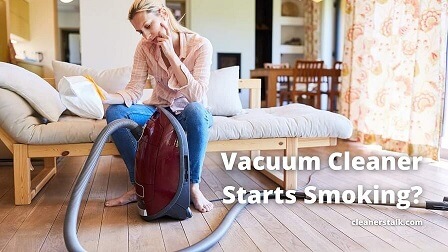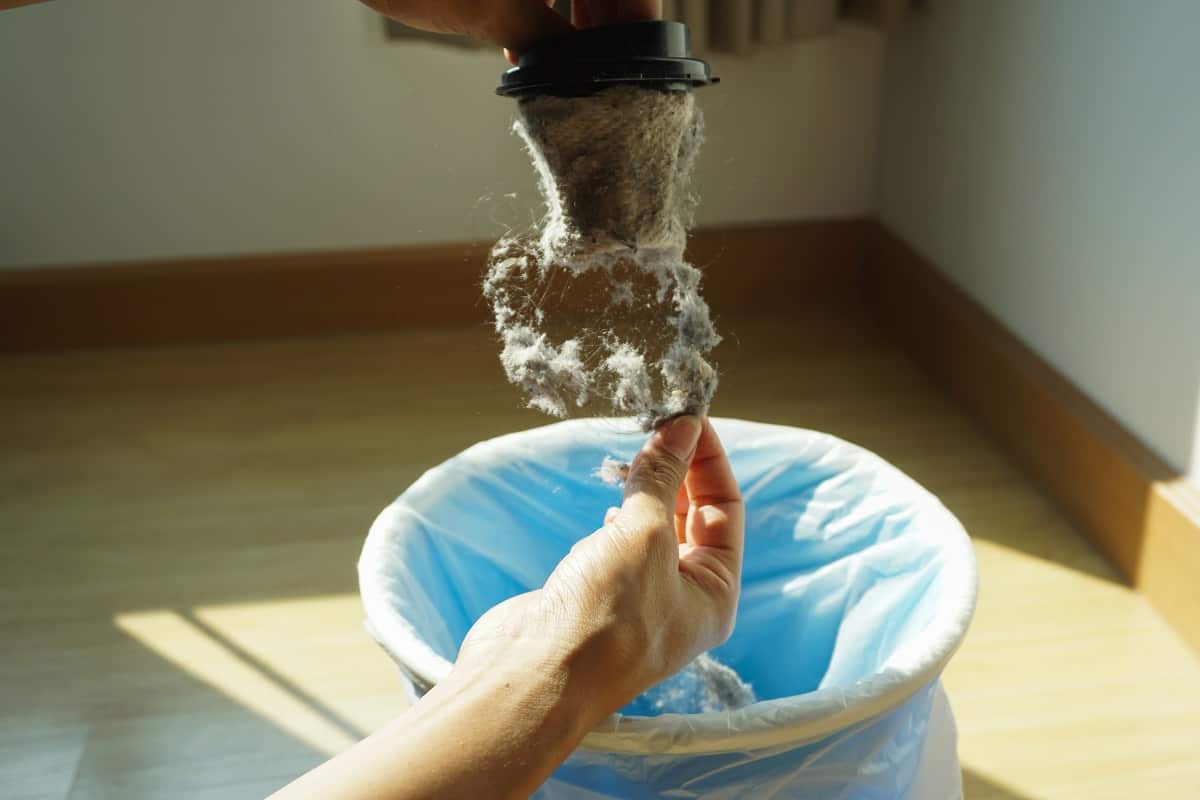
What to Do If Your Vacuum is Smoking? Beginner’s Guide
Cleaners Talk is reader-supported. This post contains affiliate links, we may earn a commission at no additional costs to you. As an Amazon Associate we earn from qualifying purchases.
If your vacuum is smoking, your first reaction may be to panic. Many would think that their vacuum cleaner is broken, and they have to buy a new one. However, a smoking vacuum cleaner often looks worse than it actually is. If you know what to address, this situation is a quick and easy fix.
What to do if your vacuum is smoking? A smoking vacuum is caused by a problem with the belt. If it fails to rotate, it begins producing smoke. If your vacuum is smoking, check if the belt is worn out or damaged, then simply replace the belt while also cleaning the brush roll to prevent clogging.
With that said, there are other variable causes of why a vacuum would smoke. Think of it as a signal. If a vacuum starts smoking, it is giving you a sign that something is wrong. In this post, we will answer why a vacuum cleaner produces smoke and what to do if your vacuum is smoking.
Why Would a Vacuum Produce Smoke?
A smoking vacuum cleaner is caused by a problem with the belt. It can either be damaged or clogged, causing the motor to overheat and start smoking. The belt may then suffer heat blistering, tearing or stretching, all of which create a burnt smell. The three main culprits that cause damage to the belt are:
1. Belt Problems
The most common culprit is a damaged vacuum belt. A vacuum’s belt may be worn out or slipped out of position. Because the belt rotates continuously as the vacuum runs, it is normal for the belt to be damaged due to normal wear and tear. It may also be stretched, cracked, burned, or broken altogether.
Additionally, a vacuum may also produce smoke when objects and debris are caught in the belt’s path, preventing it from working. Carpet fiber, strings, and pet hair are everyday items that are often trapped in the belt. When this happens, the belt may fail to rotate, which in turn produces smoke.
2. Clogged or Faulty Brush Roller

A clogged or faulty brush roller may cause the belt to not rotate properly, thus causing smoke.
A clogged or faulty brush roller can bring problems to your vacuum cleaner. It can happen due to accumulated dust, or a large gunk stuck in it. When the brush stops rolling, the motor has a tendency to burn out the belt, thus producing smoke. Check the brush roller for objects lodged between the belt and the roller.
3. Clogged or Burned Out Motor
Sometimes, the motor on your vacuum cleaner may simply stop operating and burn out. This can happen due to several things, but the most common is overuse of the vacuum. An old vacuum cleaner with an old motor may not have the strength to bear the heavy load of cleaning your house anymore.
If your vacuum motor is burned out, you need to replace it or buy a new vacuum cleaner. Replacement of your motor is best done by the authorized brand specialist. You may also consider buying a new vacuum cleaner. Nowadays, the best upright vacuums do a great job of cleaning your house efficiently.
Alternatively, the motor of your vacuum cleaner, whether old or new, may accumulate dust over time. You can be surprised by the amount of dust gathered inside your vacuum. When the dust becomes too much, it may produce smoke as the motor burns the dust off. It can also burn the belt, which causes smoking.
What to Do If Your Vacuum is Smoking?
If you have diagnosed the cause of smoking, you can proceed to solve the issue. Generally, a smoking vacuum cleaner can easily be fixed by simply replacing the belt and cleaning the brush roller. To better visualize the process, watch the quick and easy guide in the video below. You can also read the article below.
1. Replace the Belt
If the belt is damaged, it must be replaced. Be sure to buy a replacement belt based on your vacuum’s make and model number. Once you have the replacement belt, you can simply replace the belt yourself by following the instructions on the user manual, or have a professional repair service do it for you.
To replace the belt yourself, start by removing the cover. Once the cover is removed, you can easily locate the belt. In most cases, the belt is held in place by two shafts. For easy removal, consider cutting the old belt off with a pair of scissors. Place the new belt by stretching it over the shafts.
Next, you need to clean the brush roller...
2. Clean the Brush Roller
To clean the brush roller, remove it from the vacuum. Cut through any hair and debris with a pair of scissors or cutter, and pull them out with your hand. Once the brush roller is clean, put it back in place. It’s a good idea to clean your brush roller frequently to prevent clogging, which may cause the belt to not rotate properly.
Before putting the cover back in place, spin the brush roller with your hand to check if the belt is secure. Once everything is in place, clean the interior components of the vacuum, then put the cover back in place. Your vacuum cleaner should no longer smoke after both replacing the belt and cleaning the brush roller.
How to Prevent the Vacuum from Smoking

Not only should you clean the dust bag, you should also clean the filter assembly regularly to prevent clogging.
An effortless way to keep your vacuum cleaner in good working condition and prevent it from smoking is regular maintenance. Remove hair and trapped debris from the brush roller as frequently as possible. Empty the vacuum bag or canister before it reaches maximum capacity.
Moreover, the air filter should be washed regularly or replaced at least once per year. If your vacuum uses a HEPA filter, replace it every six to eight months. Doing these simple maintenance goes a long way in preventing your vacuum cleaner from smoking. Take care of it and it will take care of you. 🙂
PRO TIP: If your vacuum cleaner suddenly stopped working, it’s a good idea to troubleshoot the problem. We have a dedicated guide written with beginners in mind to help you diagnose a vacuum cleaner that has stopped working. If you are unsure what to do, simply read our article here to find the best solution possible.
Final Thoughts
And there you go, the complete article to answer: what to do if your vacuum is smoking? Now that you know all smoking vacuum problems originate from the belt, you can simply replace it. Furthermore, it’s a good idea to clean and maintain your vacuum cleaner regularly to prevent it from smoking in the first place.
